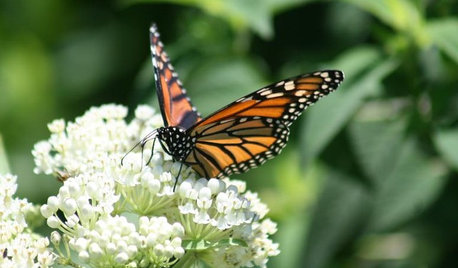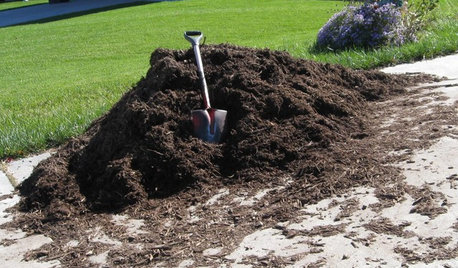Organic Lawn Care FAQ Cut Off?
raymondo17
9 years ago
Featured Answer
Sort by:Oldest
Comments (10)
trussin.22
9 years agoraymondo17
9 years agoRelated Discussions
Organic Lawn Care
Comments (20)I disagree. Compost is not fertilizer at all. It is depleted fertilizer. The stuff that went into making the compost was fertilizer back then, but now that it is finished compost, it has been fully decomposed. The fertilizer value, compared to real organic fertilizer, is nill. Back in the 1930s, J.I. Rodale proposed the idea that compost was the gold standard for organic gardening. That idea persisted until the 1990s when DNA testing on the soil revealed the true nature of soil. Prior to that testing, botanists had been able to grow about 12 different soil based fungi and bacteria in the laboratory. They figured there more than that actually in the soil and proposed that there would be as many as 50 different microbes. The first DNA testing revealed there were 30,000 to 35,000 different microbes. Subsequent testing in the 2000s revealed upwards of 100,000 different species of soil microbes. These are the guys which have been supporting life on the planet for billions of years. All of a sudden the teaching of Rodale was out the window. Feeding the microbes was found to be the solution to organic gardening. Compost has little to no food value left after the concentrated decomposition process. Instead the idea of feeding real food to the microbes came into vogue. The real food of choice is corn, wheat, soy, alfalfa, and other protein sources. These are usually available at your local feed store for $12 for a 50-pound bag and up. The application rate is 20 pounds per 1,000 square feet. It can be applied at double the rate with no harm. It can be applied at double the rate every week of the growing season with no harm. The cost per application is about $5 per 1,000 square feet. Compost, on the other hand, can cost up to $75 per 1,000 square feet depending on whether you need to have it delivered. Most people over apply compost bringing the cost to $150 per 1,000. When you apply that much compost to a lawn, it will smother it leaving a bigger mess than ever. Thus I disagree with the idea that compost is as good as anything. It is worse than almost anything and costs a small fortune....See MoreWhere is the FAQ for Organic Lawn Care?
Comments (4)If you do an Internet search for "organic lawn care faq," you'll find it all over. I have been working on an update over the years but will not be updating it at GW. When I finally do post it, the new version(s) will go onto a new forum. It is a new lawn care site and forum that several of us lawn care enthusiasts worked on over the winter. It just had a Grand Opening on March 1st. Linking to competing forums for the sake of proselytizing is tacky at best and a violation of the terms of service at worst, so if you are interested, you'll have to find it yourself. Google is a good place to start. I have the same screen name here as there (and elsewhere), so that should be enough hints....See Moreorganic lawn care for dummies?
Comments (20)There are several places that I know of where you can buy the grains. You usually have to have them order it for you, as they don't always have it in-stock. The first is Westwood Feed in Westwood. It is probably a 20 to 30 minute drive for you, but you can order once and fill your car with everything you need for the year. I was at another once, and after searching on Google a bit, I think it is Mikes Feed Farm in Riverdale. I think that would be closer to you. I find that the NJ feed stores don't quite compete on price with the feed stores in the more rural parts of the country, especially on corn gluten meal. Westwood Feed only stocks the commercial brand corn gluten meal, and they charge a bundle for it, yet their soy bean meal is moderately priced. Having experimented with organics a bit over the past year and watching others in my neighborhood, I have concluded that the fastest way (though not the most ORGANIC way) to get there is to cheat the first year and use a synthetic preemergent in the spring. Then you can breath a bit without all of the weeds and plan your attack for the fall. I didn't do that this year, and I paid the price. I am getting nice results from my overseeding, but I think the whole summer and overseeding process would have been easier had I used a preemergent in the spring. Going forward, I am going to use a preemergent as long as I still have bare spots in my lawn and any sign of disease (I moved in last September and have since found out that historically my lawn dies out in spots late every summer despite getting adequate water - I think it is some type of fungus). All of my other feedings are organic. Once the lawn comes in thick and the soil is amended properly, I will stop using the preemergent....See MoreSome issues six months into organic lawn care program
Comments (7)The unmowed photo of side A clearly looks like you have some nut sedge mixed in. I've got some of that too, but it doesn't bother me because it almost looks like St Aug. The nut sedge can easily be removed by hand, but I bet if you cut back a little on your irrigation, it will get choked out by the turf. It looks like there is too much nut sedge to spot treat with vinegar. I've also heard molasses works, but I don't have any experience with that method. Side B looks like you may have some fungus problems. How much are you watering? How often? Be patient and stick with the organic program. It works better, and will cost less long run....See Morefourfirstnames
9 years agotrussin.22
9 years agoeaga
9 years agoraymondo17
9 years agoraymondo17
9 years agoeaga
9 years agoraymondo17
9 years ago
Related Stories

KITCHEN DESIGN8 Kitchen Sink Materials to Consider
Learn the pros and cons of these common choices for kitchen sinks
Full Story
COMMUNITYWant a Cleaner, Safer Neighborhood? Show You Care
Our behavior strongly influences others, says a new study. Show neighbors you care about your street and watch them follow suit
Full Story
GARDENING GUIDESTree Care: Common Tree Diseases and What to Do About Them
Learn to recognize trees that may be affected by diseases or pests so you can quickly take action
Full Story
GARDENING GUIDESHow to Keep Your Trees Healthy
Ensure your trees’ vigor for years to come with these tips for protecting roots, watering effectively and more
Full Story
ORGANIZING6 Ways to Care for Your Washing Machine
Keep your laundry room and clothes in great shape with these basic washing machine tips
Full Story
GARDENING GUIDES7 Ecofriendly Gardening Ideas That Also Cut Chore Time
Spend less time weeding, less money watering and more moments just sitting back and enjoying your healthy garden
Full Story
FRONT YARD IDEASBefore and After: Front Lawn to Prairie Garden
How they did it: Homeowners create a plan, stick to it and keep the neighbors (and wildlife) in mind
Full Story
LANDSCAPE DESIGN7 Low-Maintenance Lawn Alternatives
Turf isn't the only ground cover in town. Get a lush no-grass lawn with clover, moss and other easy-care plants
Full Story
WOODWORKINGHow to Clean and Care for Your Butcher Block
Keep butcher block counters and boards looking sharp as a knife — and sanitized for safe food prep — with this advice from a pro woodworker
Full Story
DENS AND LIBRARIESHow to Care for Your Home Library
Increase your enjoyment of books with these ideas for storing, stacking and displaying them
Full Story


eaga